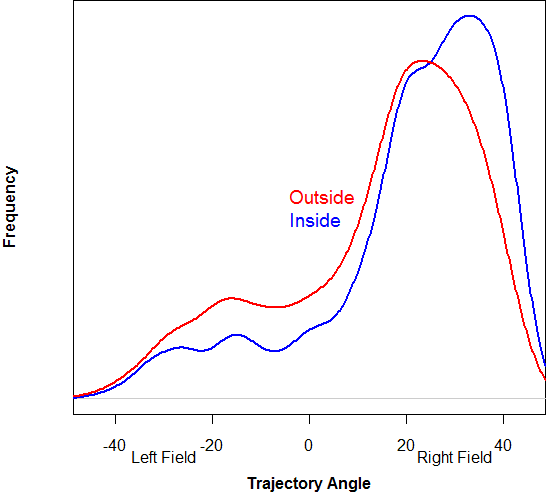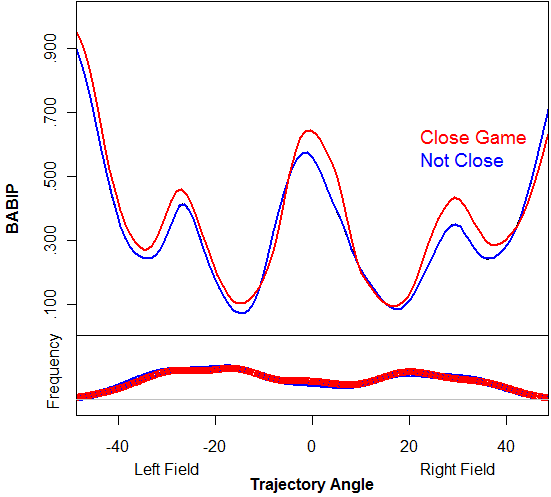
| Touching Bases | June 29, 2010 |
Last week, I explored the difference between those players who hit with the shift and those who do not. It would be useful to show that the shift does, in fact, play a part in BABIP, and the observed effect was not only a product of different player pools. So I took the 16 players I believe to be semi-regularly shifted and found their groundball data with men on base vs. with no men on. This serves as a proxy that shows whether the defense is shifting them or not. Below is a plot of the 16 batters' groundball average based on trajectory angle and, below that, a plot showing the frequency at which these batters hit to each angle.

With men on, these pull hitters are able to pick up more hits on balls up the middle and in the 3-4 hole. The shift is most effective on balls in these locations, so this makes sense that these vacated holes result in hits. However, I think balls directly at the first baseman go for hits more often with men on base because the first baseman has to hold the runner on and not because the shift is off. The only place where there is an improved BABIP when the bases are empty is on balls down the third base line.
I've heard the argument that the shift takes away the outer part of the plate from the pitcher. Under this logic, the shift actually works to the hitter's advantage, as any ball that's on the outer half can be easily taken the other way for an automatic hit, and therefore the pitcher must pitch predictably inside. Using the same sample, I split the plate into halves and found the groundball distribution.

I think the takeaway here is that it's not natural for these guys to hit down the third base line. So unless they decide to change their approach dramatically, i.e. bunt, the defense can vacate third base, and the pitcher can pitch outside with no fear of a hit going right down the line.
The other unusual infield alignment, besides the shift, is the infield in. I searched for all grounders with a man on third in the seventh inning or later, which is when the infield might be drawn in. I just began the process of linking the Gameday database to Retrosheet, so unfortunately, I don't yet have data that indicates the number of outs or the score during each at bat. Instead, I broke the data into two groups based on whether the final score of the game was close (one or two runs) or not. In a blowout, teams never bring the infield in.

I don't have much confidence in the crude distinction between these two groups. This neither proves nor disproves that that batting average on groundballs goes up .100 points with the infield in. There might be evidence that bringing the infield in surrenders hits on balls in the holes, but not necessarily at the fielders.
Finally, I looked at bunts. I took all bunts that occurred with the bases empty, so I knew the batter was bunting for a hit, and split the data by handedness.

RHBs are most successful bunting down the first base line, where they bunt more often than LHBs. LHBs are most successful bunting toward third, where they bunt more often than RHBs.
I feel like there are wins to be had here. The difference between a third baseman playing in for a bunt or playing behind 2nd base in a shift isn't trivial in preventing runs. I don't know if it would be asking too much for the bench coach to study spray charts and plan defensive alignments for the opposition, but then again, I don't know what a bench coach does. What does a bench coach do?
Comments
Good stuff, Jeremy. The most important bench coaches are in Atlanta and Chicago because they take over the manager's duties when Bobby Cox and Lou Piniella get thrown out of a game. They are usually former base coaches who have moved up (down?) in the world. It is also very important that they know how to take orders from their ejected managers who are positioned down the tunnel to the clubhouse.
Posted by: Rich Lederer at June 29, 2010 7:28 AM